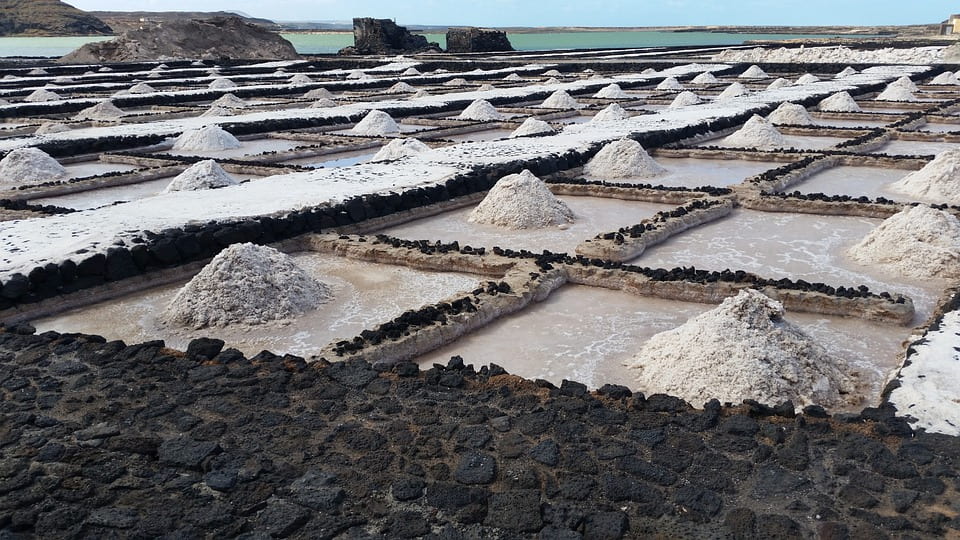I walk down the spice aisle of my local grocery store. It smells like pepper and cinnamon, but all I need is salt. Scanning the shelves of alphabetically arranged spices, it isn’t there. It has a display all its own, just to the left. And there’s not just one type. There are many. Mediterranean sea salt, iodized salt, black truffle salt, kosher salt, smoked salt, the list goes on. But what’s the difference?
According to Samin Nosrat, in her bestselling book, “Salt, Fat, Acid, Heat”, salt is the “most important element of good cooking,” so you have to have it. But what kind should you get? Well, it depends on what qualities matter to you. Is it the geology? The chemistry? The size of the crystal grains? Or maybe the flavor?
From a geologic perspective, salt is a mineral called halite. Halite or sodium chloride is found in seawater. A mineral is anything that has a set chemical formula (although ion substitutions are allowed) that has a set, repeating crystal structure. This base repeating structure can be repeated as long as the right ions are present. But if the chemical formula is always the same, how are there so many types of salt?
Almost all of the salts at the grocery store are sodium chloride (halite), but the main exception is salt substitute, or potassium chloride, meant for those with dietary sodium restrictions. The potassium ion has the same ion charge as sodium, and can therefore substitute for the sodium, even though the potassium ion is nearly twice the size. This changes the crystal structure slightly by making the base repeating unit larger. Otherwise, the structure is unchanged.
How do we get salt? There are multiple ways to extract salt: mining underground salt deposits, evaporating sea water (which leaves the salt behind as crystals), solution mining (pumping a salt deposit full of water, bringing that water to the surface, and boiling the water to get the salt crystals quickly). Check out these infographics for more information.

All salt originates at some point from the sea. But not always today’s seawater. For example, the pink salt from the Himalayas is actually mined from deposits made from seas 250 million years ago during the Jurassic, when dinosaurs roamed. Just like other minerals, salt comes in multiple colors due to trace amounts of other elements (such as iron, potassium, and magnesium). Translucent white is the standard (pure) color (unmarred by trace elements), but the prevalence of salt lamps indicates the presence of a pink-hued variety mined in the Himalayas. This color is actually from iron in the salt. Just like rust is red, salt with iron is too. Salt lamps just have smaller proportions of iron than rust, which is diluted in the salt lamp. The low amount of iron causes the lamp to be pink instead of red.

One salt that is chemically different without a change in taste or appearance is iodized salt. Iodine is a liquid at room temperature, but when it is bonded to sodium as sodium iodide (NaI), it is solid at room temperature. NaCl and a small amount of NaI are combined to create iodized salt. This combination is naturally occurring, but not widespread. As the two solids are mixed together, the chemical structure of the halite is unaffected. The Midwest lacks natural iodized salt. This led to an epidemic of children with goiters (enlarged necks) in the 1920s, which can be treated with iodine consumption.
What’s different about Kosher salt? Kosher salt is coarser (bigger crystals) than table salt. Although the term Kosher usually indicates an oversight process, Kosher salt gets its name from its utility in koshering meat. Larger crystals assist in the blood removal process, which is a requirement for meat to be kosher. Paradoxically, this means that not all Kosher salt is Kosher certified. Aside from the larger crystals, Kosher salt is not different from table salt.
The final category of salts are the culinary salts. These are typically table salt with additional ingredients or preparation. Black truffle salt has black truffle mushrooms, smoked salt has been smoked, spice blends marketed as salts typically include salt, but have a host of other spices too. There are also finishing salts, typically coarser-grained to sprinkle on finished dishes, that are table salt in composition.
Next time you’re in the spice aisle, you will see all of the salts packaged to stand out and be different, and you will know that they aren’t so different after all.
Edited by Clara Boothby and Lana Ruck

Do any of these products completely dry down sea salt so that all of the trace elements are included (magnesium, bromide, fluoride, iodide, potassium, calcium, sulfate, etc.) rather than, as I suspect, crystallize only the sodium chloride and throw away the valuable trace minerals?